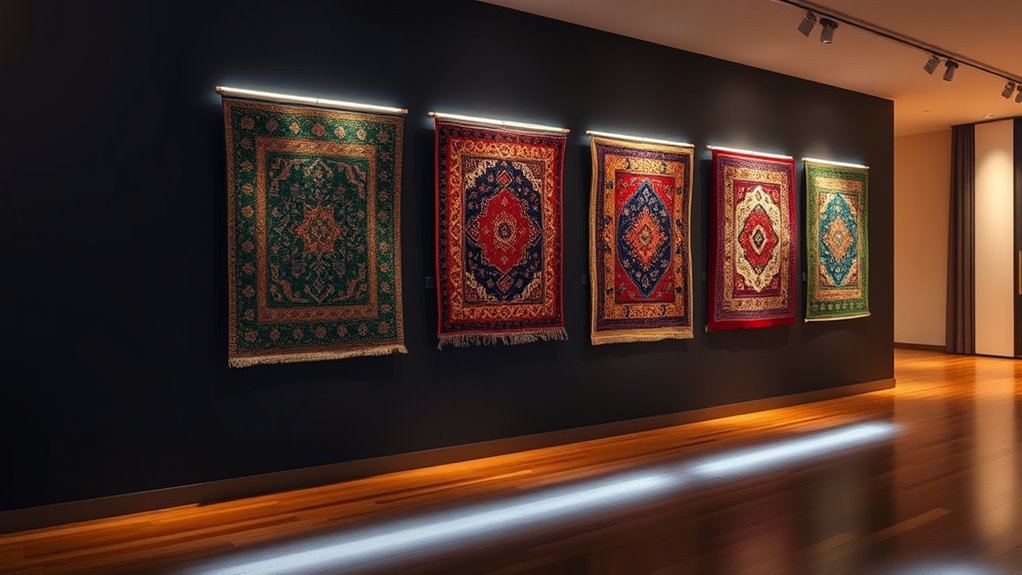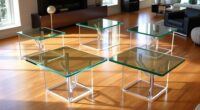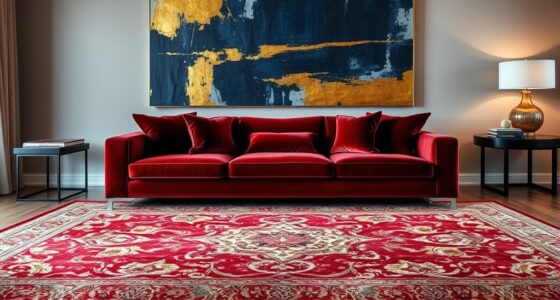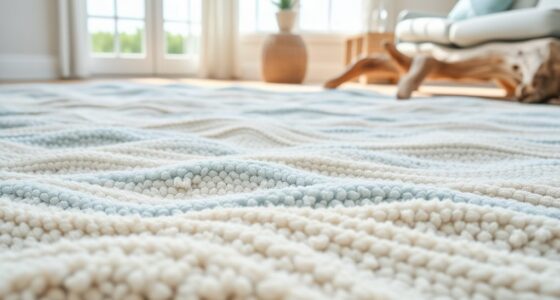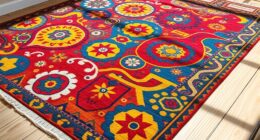To create gallery-style rug lighting at home, assess your space to plan fixture placement based on rug size and layout. Choose adjustable fixtures with warm or cool bulbs, and position them at a 30-degree angle to avoid glare. Use layered lighting—ambient, accent, and task—to add depth and highlight textures. Regularly maintain and fine-tune your setup for ideal effect. Keep exploring for detailed tips on designing and maintaining your perfect lighting scheme.
Key Takeaways
- Assess your space and rug placement to determine optimal lighting positions and fixture types.
- Select adjustable fixtures and bulbs with appropriate color temperatures to highlight textures and colors.
- Install layered lighting, combining ambient, accent, and task lights for depth and visual interest.
- Position lights at a 30-degree angle to prevent glare and ensure even coverage of the rug.
- Regularly maintain and fine-tune lighting angles and fixtures to preserve optimal illumination and aesthetic appeal.
Assessing Your Space and Planning the Layout
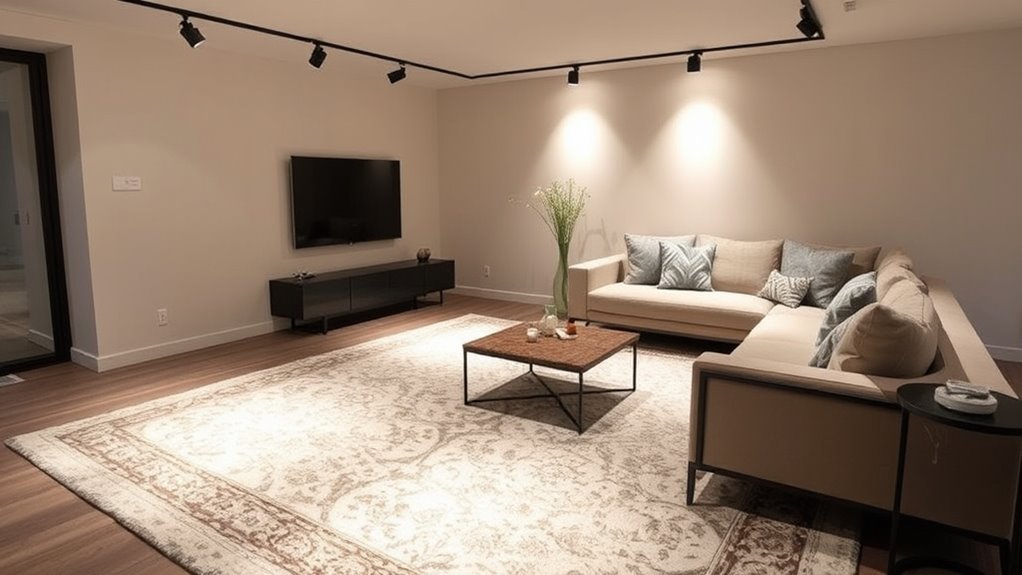
Before you start installing gallery-style rug lighting, it’s essential to assess your space and plan your layout carefully. Consider the size of the room to determine how much lighting you need and where it should be placed. Larger spaces may require multiple light sources to evenly illuminate the rug, while smaller rooms might need fewer fixtures. Think about your rug placement—whether it’s centered or offset—and how the lighting will highlight its features. Measure the distance from walls and furniture to identify the best positions for your fixtures. Planning ahead guarantees your lighting enhances the rug without creating shadows or glare. Incorporating lighting strategies can help optimize the overall effect and achieve a cohesive look. A well-thought-out layout makes the installation process smoother and results in a balanced, aesthetically pleasing setup. Additionally, considering ambient lighting options can further enhance the atmosphere and highlight the rug’s textures and colors effectively. Understanding the importance of layered lighting can also create depth and visual interest in your space. To ensure safety and functionality, selecting appropriate fixtures that suit your specific needs is crucial for a successful installation. Properly measuring distances between fixtures and other elements will help avoid uneven lighting and shadows.
Choosing the Right Lighting Fixtures and Bulbs

Selecting the right lighting fixtures and bulbs is essential to achieving a balanced and attractive gallery-style rug display. Your choice of lamp types influences the overall ambiance and focus, whether you opt for track lighting, adjustable spotlights, or wall-mounted fixtures. When choosing bulbs, consider bulb colors that complement your rug’s tones and enhance its details—warm whites create coziness, while cooler tones highlight patterns sharply. Pay attention to fixture placement and flexibility to direct light precisely where you want it. Good lighting should avoid glare and shadows, making every detail stand out. Here are some tips:
Choose adjustable fixtures and warm or cool bulbs to highlight your rug’s details without glare.
- Pick adjustable lamp types for versatility
- Use bulbs with a color temperature that enhances your rug
- Go for fixtures that blend seamlessly with your decor
- Ensure bulbs provide sufficient brightness without overpowering the space
- Proper lighting placement is also crucial in highlighting the textures and patterns of your rug effectively.
- Additionally, considering retail hours can help you plan visits to stores with a wider selection of lighting options and knowledgeable staff.
- For optimal results, understanding lighting principles can help you create a harmonious and inviting display.
Positioning Lights for Optimal Rug Illumination
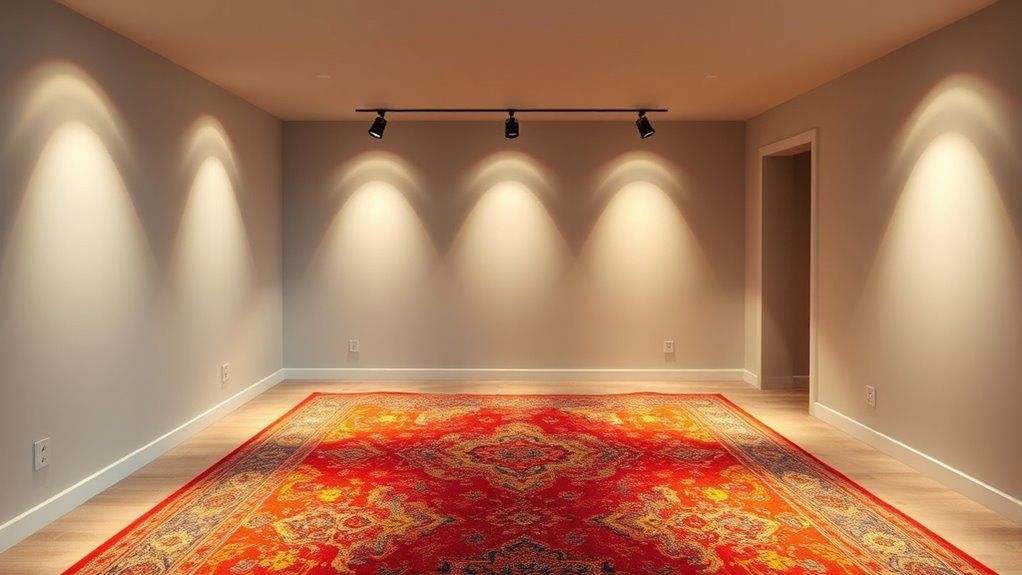
Properly positioning your lights guarantees your rug’s details and colors are showcased effectively. Use artistic lighting to highlight textures and patterns, creating a gallery-like effect. Place adjustable fixtures at a 30-degree angle to avoid glare and shadows, ensuring even coverage. Keep in mind that the right color temperature enhances the rug’s hues; warmer tones (2700K–3000K) add coziness, while cooler tones (4000K–5000K) emphasize clarity and vibrancy. Aim your lights to minimize reflections and dark spots, focusing on even illumination across the entire rug. Test different angles and distances to find the most suitable setup for your space. Proper positioning combines artistic lighting principles with thoughtful placement, making your rug a focal point that truly pops. Incorporating diverse lighting designs can further enhance visual interest and highlight the rug’s unique features, creating a stunning visual presentation.
Installing Track and Accent Lighting Systems
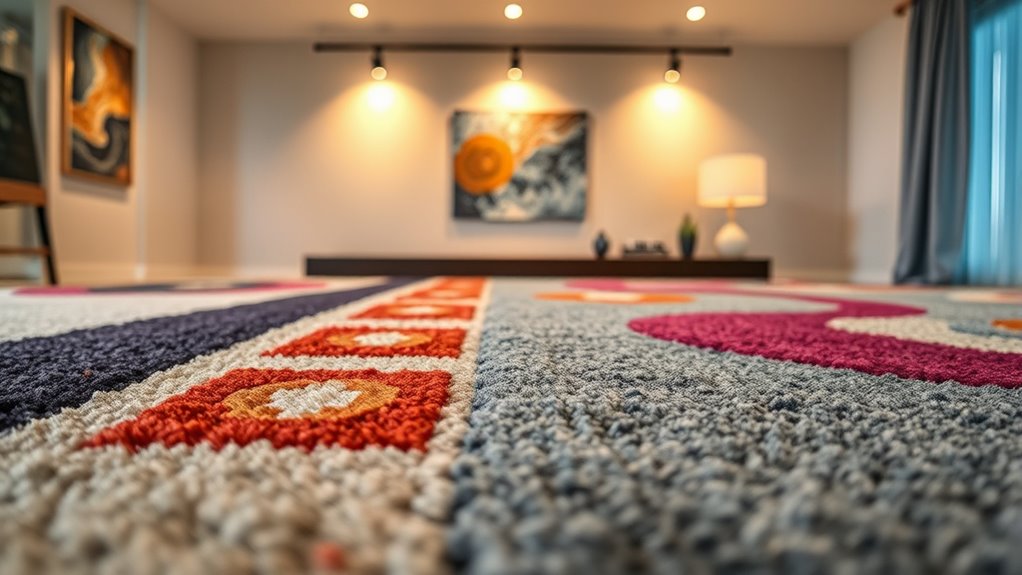
Installing track and accent lighting systems provides a flexible and stylish way to highlight your rug’s features. These systems let you easily modify lighting angles, creating ambient effects that enhance textures and colors. Using adjustable fixtures, you can set the perfect color temperature to evoke warmth or coolness, complementing your decor. This approach makes your rug a focal point without overwhelming the space.
Installing adjustable track lighting enhances your rug’s features with customizable ambiance and elegant focal points.
Consider these tips:
- Choose track systems with dimmable features for versatile lighting control
- Use adjustable fixtures to target specific rug areas effectively
- Experiment with different color temperatures to achieve desired ambiance
- Incorporate ambient effects by varying light angles and intensities
- Understanding city dynamics can help you position lighting to best showcase your rug in different room layouts.
This setup ensures your rug’s details stand out beautifully, adding depth and elegance to your room.
Creating Layered Lighting for Depth and Dimension
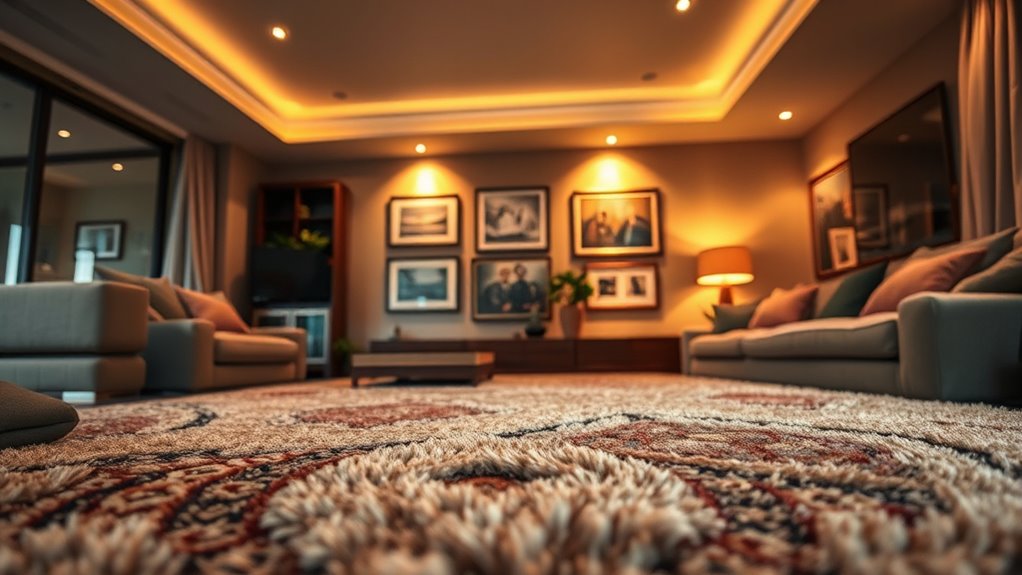
Building layered lighting into your rug setup adds visual interest and enhances the room’s overall depth. Use ambient layering to create a soft, inviting glow, balancing brighter accent lights. Varying color temperature helps add warmth or coolness, shaping the mood and highlighting textures. Incorporate multiple light sources at different heights and intensities for dimension. For example, combine overhead fixtures with wall-mounted lights or spotlights. Adjusting the color temperature of each layer can emphasize the rug’s colors and patterns, making the space more dynamic. Selecting the right lighting products is essential to achieve an effective layered effect. Here’s a visual guide:
| Light Type | Purpose |
|---|---|
| Ambient Lighting | Sets overall mood |
| Accent Lighting | Highlights specific features |
| Task Lighting | Focused for details |
Additionally, understanding the importance of website performance metrics can help you optimize your lighting setup to create the desired ambiance. Proper placement and selection of fixtures also contribute to a cohesive and visually appealing design, reflecting the layered approach seen in architectural preservation efforts.
Tips for Maintaining and Adjusting Your Gallery-Style Setup
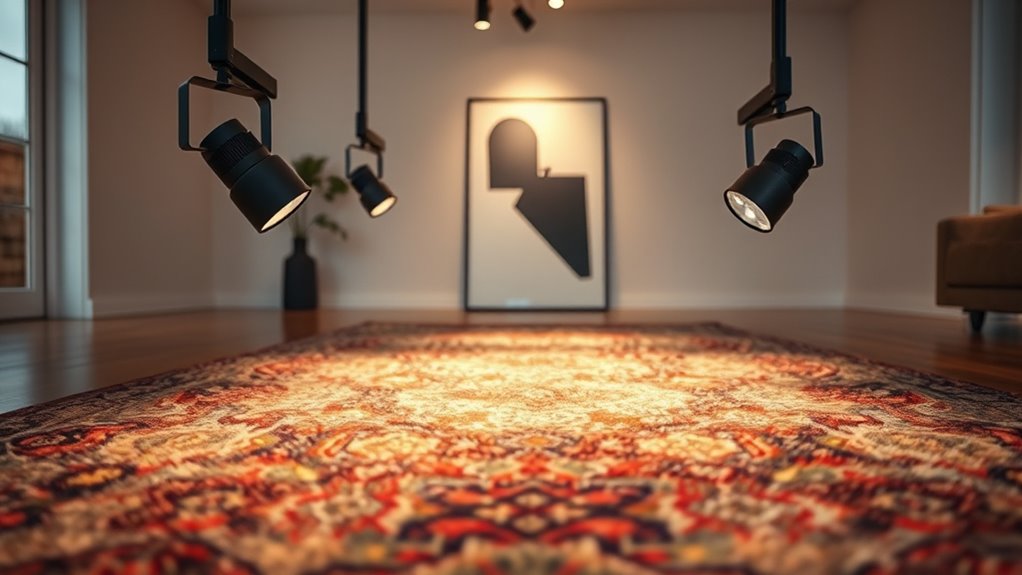
To keep your gallery-style rug lighting looking its best, you need to regularly check and fine-tune your setup. Adjusting the light angles can enhance your display and prevent glare, while routine maintenance guarantees everything stays in top condition. Taking these small steps helps your artwork stay beautifully illuminated over time. Incorporating proper lighting techniques can further improve the visual impact of your gallery. Being aware of resources and tools available for lighting adjustments can also assist in maintaining an optimal setup.
Adjusting Light Angles
Have you ever noticed how a slight change in the angle of your gallery-style lighting can dramatically enhance the appearance of your artwork? Adjusting the light direction and lamp placement can make a big difference in highlighting details or reducing glare. To fine-tune your setup, start by moving the lamps slightly until the light hits the piece just right. Keep in mind that even small adjustments can change shadows and focus.
- Experiment with different angles to find the most advantageous light
- Avoid direct, harsh lighting that causes glare
- Position lamps to minimize shadows on the artwork
- Rotate or tilt lamps for ideal light distribution
Regular Maintenance Checks
Regular maintenance checks are essential to keep your gallery-style lighting looking its best and functioning properly. Following a consistent cleaning schedule prevents dust buildup and keeps your setup bright. During inspections, check for flickering bulbs or dimming lights, which may signal it’s time for bulb replacement. Regularly clean fixtures and lenses with a soft cloth to maintain ideal light quality. Use this table to guide your maintenance:
| Task | Frequency | Tips |
|---|---|---|
| Cleaning fixtures | Monthly | Turn off power before cleaning |
| Bulb replacement | As needed | Use the correct wattage |
| Check connections | Every 3-6 months | Ensure wires are secure |
Staying proactive ensures your gallery lighting remains stunning and effective.
Frequently Asked Questions
How Can I Prevent Glare on Shiny or Reflective Rug Surfaces?
To prevent glare on shiny or reflective rug surfaces, focus on glare reduction techniques. Use diffused lighting or soft, indirect light sources to minimize harsh reflections. Position lights at angles that avoid direct reflection into your eyes, and consider using matte or non-glossy rugs to reduce reflective surface issues. These reflective surface tips help you enjoy your space without uncomfortable glare, creating a cozy, well-lit environment.
What Energy-Efficient Lighting Options Are Best for Long-Term Use?
While it’s tempting to choose flashy options, you’ll find that LED bulbs are your best bet for energy-efficient, long-term lighting. They use less power, last longer, and provide excellent illumination. Plus, solar options offer a sustainable alternative, especially for outdoor or well-lit areas. By opting for these, you’re not only saving energy but also making a thoughtful choice that benefits your home and the environment over time.
How Do I Choose Lighting Colors That Complement My Rug Design?
When choosing lighting colors that complement your rug design, focus on color coordination to highlight its features. Opt for warm tones to create a cozy, inviting mood, or cooler shades for a modern, calming effect. Consider the rug’s colors and patterns, and select lighting that enhances them without overpowering. This approach not only boosts visual appeal but also mood enhancement, making your space feel more harmonious and thoughtfully curated.
Can I Install Gallery-Style Lighting Without Professional Help?
Yes, you can do DIY installation of gallery-style lighting, but it depends on your comfort level with electrical work. You’ll need basic tool requirements like a screwdriver, wire strippers, and possibly a voltage tester. Carefully follow the manufacturer’s instructions and safety guidelines. If you feel unsure about handling electrical components, it’s best to consult a professional to avoid hazards. Proper installation guarantees your rug lighting looks great and stays safe.
What Safety Precautions Should I Consider During Installation?
When installing gallery-style rug lighting, you should prioritize safety. Always turn off the power before working on electrical wiring to prevent shocks. Use proper tools and guarantee your wiring connections are secure and insulated. Keep fire safety in mind by avoiding overloading circuits and using rated fixtures. If you’re unsure about any step, it’s best to consult a professional to avoid potential hazards and assure a safe, successful installation.
Conclusion
Now, picture your rug bathed in warm, inviting light, each fiber subtly highlighted like artwork in a gallery. With your carefully planned layout and perfectly positioned fixtures, you’ve transformed your space into a stunning visual showcase. As you adjust your lighting, imagine the cozy glow gently shifting, revealing new details and textures. Your home now feels like an art gallery, where every step invites admiration and appreciation for your beautifully illuminated rug.
